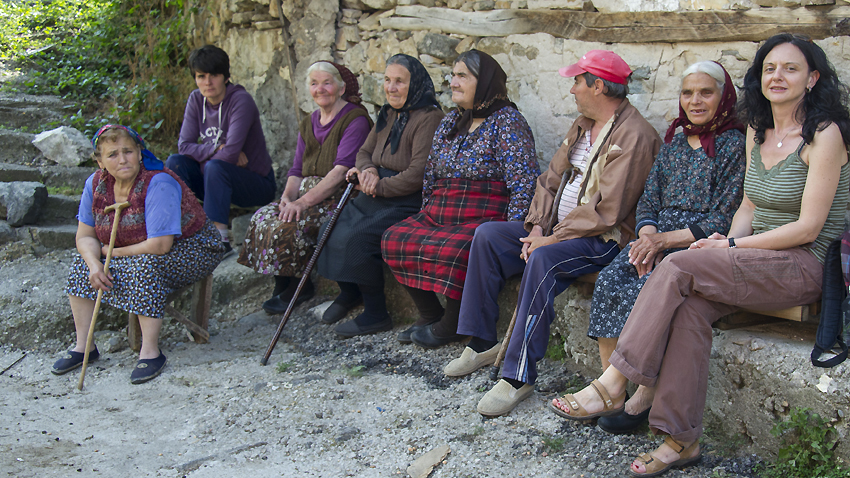On January 31 the Zmey, Zmeytsa, Lamya and Hala book will be presented in the Big Salon of the Bulgarian Academy of Sciences. The authors of that collection gathered in more than 400 pages lyrics of songs and texts of fairytales, legends, sagas, riddles and proverbs. Many rituals, magic practices, as well as contemporary anecdotes and stories, which have been recorded in recent decades, also entered that book. The Bistrishki Babi (Grannies of Bistritsa) multi-generational female folk formation will also take part at the presentation of that collection. Renowned Bulgarian actress Tatyana Lolova will read some texts from the new book. The editor-in -chief of Zmey, Zmeytsa, Lamya and Hala book Associate Professor Dr. Vihra Baeva told Radio Bulgaria details:
“The book was published due to a project developed by a team of the Institute of Ethnology and Folklore Studies with Ethnographic Museum at the Bulgarian Academy of Sciences. I worked together with twelve other colleagues for three whole years on that book. We found texts which were kept at the institute's rich and interesting archives. We also used private archives. We tried to up-date the language to some extent and edit the texts slightly. We also made short comments, in order to help contemporary readers sink into the world of folklore.”
“The bright, colorful and intriguing image of the dragon (zmey) is present in all genres of Bulgaria's folklore. Nowadays, that dragon-like creature is part of many anecdotes and funny stories, especially in the Internet anecdotes, which are an active folklore genre. Zmey, lamya and hala are relatives, because all of them are serpent-like creatures. The snake is a real animal species, although it is very rich in symbolism, whereas zmey, hala (dragon-like creature in Bulgarian folklore) and zmeytsa (female dragon) are fiction. Many people contend they have seen such creatures. Zmey is the main image in the local folklore. It is associated with the underworld. However, it can be also associated with heaven, because it can fly, breathes fire and looks like a fiery ball when it flies up in the skies. On the other hand, zmey is associated with water, because it lives in wells, rivers and springs. It also dwells in high trees and is famous in the local folklore as Zmey Goryanin (forest dragon). That image was present in the folklore of our ancestors and makes me believe that it inherited the image of an ancient divinity, which was not preserved in its original look due to Christianization.”

In most Orthodox Churches two zmeys are depicted symmetrically at the base of the cross placed in the middle of the altar rail. How that image is perceived in Christianity? More from Associate-Professor Baeva:
“In Christianity zmey is usually regarded as a demon. It is associated with Satan. Some saints, including Saint George fight against the zmey. That epic fight represents the battle between good and evil. The Saints always slay the dragons, because they are driven by the power of faith, thus popularizing Christianity. There is a folklore interpretation of the image of the two dragons depicted at the base of the church cross which reads that that dragon-like creature is guarding his own possessions. Images of zmey can be also seen outside the churches above the church gates.”
The book also contains texts dedicated to the closest relative of the dragon - the female dragon (zmeytsa). Zmeytsa is also a very dangerous creature, just like the zmey, because all lads and lasses who fall in love with them start ailing and feel weak. Lamya is mainly associated with greed and insatiable hunger. It devours everything and steals crops, thus dooming people to famine. The Hala is mainly associated with the weather, the storms and the hailstorms which destroy crops.
English version: Kostadin Atanasov
The most genre-diverse festival produced by the National Palace of Culture has been revived under the motto "Dialogue of Colors and Thoughts", with a central theme— the unifying power of art. The National Palace of Culture has over ten festival formats,..
The New Bulgarian University announces the start of its initiative Spring Days of the Arts , a celebration of creativity and culture. From today until 5 June, more than 30 cultural and artistic events will take place, involving students, faculty and..
"Bulgarian" is the title of a new bilingual book featuring the works of Ivaylo Balabanov (1945-2021), which is being prepared for print on the occasion of the 80th anniversary of the birth of the unforgettable Bulgarian poet. Printing the book in..
With Rosencrantz and Guildenstern Are Dead , young Boyan Kracholov - one of the most compelling contemporary Bulgarian theatre directors - makes his debut..
The first major ballet event in the festive jubilee programme celebrating the 100th anniversary of the Stara Zagora Opera is the premiere of "Parisian..

+359 2 9336 661
